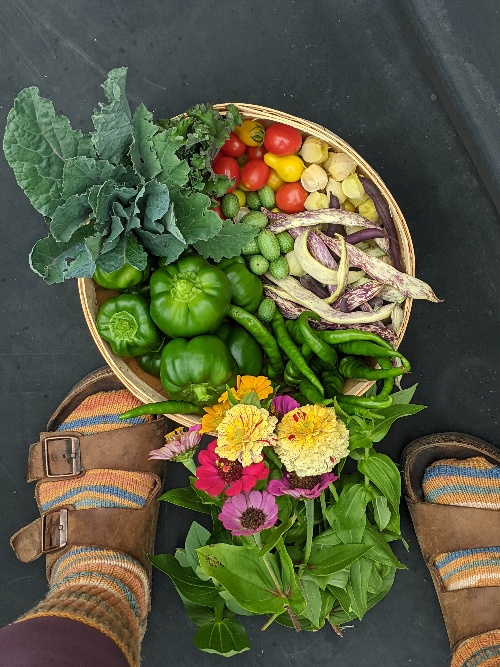
This past summer, a colony of bald-faced wasps took up residence right next to my garage door. Because I know how beneficial wasps are, I decided to leave it alone. Sure, we couldn’t use that particularly sticky door for a couple of months, but the small inconvenience was worth it.
It was such a pleasure to watch them continually build out their papery nest as it almost completely consumed the non-functioning exterior light. The wasps were always coming and going, and sometimes you could spot them carrying the bodies of insects to feed their young back at the hive.
Although bald-faced wasps have a reputation for being aggressive, this was not my experience.
Numerous times I came within a foot or two of the nest (to weed the bed below – but mostly out of curiosity), and they never once harassed me. They seemed to recognize my face and, quite correctly, didn’t perceive me to be a threat. So I – all of a sudden – had made some wasp friends.

By mid-September, the life cycle of bald-faced wasps was complete, and the usual hum of the nest was unsettlingly quiet. To be honest, I felt a little sad. All members of the colony had died except for one new queen. She leaves the hive and finds a protected spot – nestled into leaf litter or tucked behind tree bark – and enters a state of quiescence until spring.
Encouraging wildlife to inhabit your backyard might seem like a small thing, but it is incredibly important for preserving biodiversity where you live.
Here on our home turf, we can have the most direct and noticeable impact on supporting local ecosystems. This was just a single wasp colony, it’s true – but it was one that got to live out its natural cycle as part of the interconnected web of life.
The wasps provided excellent pest control for my gardens, and they, in turn, were a food source for birds and other insect-eating creatures.
Where summer is a time of plenty for wildlife, wintertime poses additional challenges. Sub-zero temperatures, ice and snowy conditions, and a limited supply of food to forage make things considerably harder for birds, deer, rabbits, squirrels, and other small critters to survive.
Even the creatures that overwinter in a state of dormancy – bats, frogs, as well as numerous species of wasps, bees, butterflies, and beetles – need an undisturbed place to shelter in order to see the spring.
Creating a winter sanctuary is really simple. By making a few small adjustments, we can offer a safe haven for many species and ensure they thrive throughout the coldest months.
1. Leave the Leaves

The availability of nesting sites and overwintering habitats has a major influence on the populations of bees and other beneficial insects in your yard come spring.
With the exception of monarch butterflies migrating south for winter, the vast majority of native insects survive by hiding in and around dropped leaves.
Leaves provide shelter from cold, camouflage from predators, and in some cases, act as an immediate food source for hatched pupae once the weather warms up.
Great spangled fritillary, wooly bear caterpillars, fireflies, and ladybugs are known to spend the winter tucked into a pile of leaves, as are worms, spiders, mites, snails, millipedes, lace bugs, and many more.
Swallowtail butterflies and luna moths overwinter in cocoons that resemble dried leaves. Queen bumblebees burrow an inch into soft earth, often below a thick, insulating layer of leaves. Red-banded hairstreaks lay eggs on oak and sumac leaves.
So when you leave the leaves – or at least some of the leaves – where they happen to lie on the ground, whole and unshredded, you are supporting a broad community of insects.
If you must move them, gently rake leaves up and deposit them into garden beds. Leaving a thin, undisturbed layer of leaves on the lawn won’t kill the grass but will go a long way to preserving these fragile overwintering habitats.
2. Leave the Flowerheads

Winter is an especially challenging time for the animals that must stay active during the cold months. Often, it’s the animal’s ability to find enough food that is most critical to survival.
Leaving standing flowers over winter is about the simplest thing you can do to provide food for wildlife. Instead of cutting annuals and perennials back in autumn, let them form seedheads. Many birds rely on seeds foraged from flowers – goldfinches, sparrows, chickadees, nuthatches, and other small birds are light enough to perch on top of the flower and pick away at the seeds.

There are many flowering plants and ornamental grasses that help keep birds fed over winter:
- Anise Hyssop (Agastache foeniculum)
- Black-Eyed Susan (Rudbeckia hirta)
- Coneflower (Echinacea purpurea)
- Coreopsis (Coreopsis spp.)
- Sedums (Sedum spp.)
- Sneezeweed (Helenium autumnale)
- Sunflowers (Helianthus spp.)
- Zinnias (Zinnia spp.)

Although birds are the greatest beneficiaries of winter seedheads, other woodland creatures stand to benefit as well. Rabbits, squirrels, voles, mice, and shrews will likewise appreciate an additional food source in the dead of winter.
3. Leave the Stems

Dead wildflower stalks and woody branches serve as cozy places of shelter for small native bees, solitary wasps, and other stem-nesting insects. They prefer hollow stalks or pithy stems with a soft core that can be tunneled through.
Leaving dead stems standing preserves these overwintering sites for small carpenter bees, yellow-faced bees, leaf-cutter bees, stem-boring moths, earwigs, spiders, and many more invertebrates. These solitary insects burrow through the stem and enter a state of dormancy until they reemerge in spring.
Their favorite wintertime hovels include the dead stems from raspberry canes, bee balm (Monarda), elderberry (Sambucus), hydrangea, asters, thistles, and yucca.
Past winter, hollow stems are still beneficial to keep around. Wait as long as possible in spring to cut back plants, making sure to leave stems at least 8 inches long. Female bees will find cut stems and lay eggs inside. Leave them be and new plant growth through summertime will rise up and hide the old stalks.
4. Make Brush Piles

In a forest setting, logs, branches and sticks pile up naturally and create shelter for small mammals, birds, reptiles, and amphibians. But of course, it’s much more difficult for wildlife to find these natural shelters in suburban environments, where dropped limbs are promptly cleared away.
At home, we can replicate brush shelters with yard waste and trimmings, and keep them tucked out of view.
Rather than carting away broken branches, prunings, sticks, twigs – basically any and all woody debris and leaf litter – toss it all in a pile or make several smaller piles. Locate your brush piles in inconspicuous spots around your yard – behind shrubs, along fence lines, in back corners, and around wildlife gardens.

Brush piles are useful to small woodland critters as shelter, cover, and place to nest. As the woody materials break down, they go on to feed insects, fungi, and microorganisms, eventually returning the nutrients back to the earth.
5. Build Rock Piles

In the wilderness, habitats come in many forms – including rocky outcrops where the spaces between cracks and crevices can serve as shelter. Something as simple as adding rock piles and dry stone walls around your landscape will host a huge range of backyard critters.
Chipmunks make burrows in the ground with entrances located under a pile of rocks, which helps provide extra protection from predators. Queen bumblebees employ a similar strategy and use abandoned underground tunnels below stones to hibernate for winter; in spring, she will build out her nest in this very spot. Leaf cutter bees make nests between the stones, and ground beetles take shelter in places where rock meets soil.

Unlike brush piles and leaf heaps, rocks don’t break down and can become long-term housing for ladybugs, fireflies, and rove beetles to keep safe over winter.
Cold-blooded animals – frogs, lizards, salamanders, turtles, and snakes – love a pile, too, since rocks absorb the sun’s heat during the day and radiate the warmth at night.
Plant wildflowers and native grasses around your rock pile to make it most appealing to beneficial insects.
6. Grow Winter Food Sources

Birds that eat insects in the warmer months usually switch over to a diet of fruit in wintertime. Non-migratory birds need to eat a lot of calories to maintain body temperature in freezing weather.
To help supplement their food supply, grow a mixture of ground covers, vines, shrubs and trees that produce berries in autumn. These fruits persist into winter and are a valuable source of food for our feathered friends.
Plants that produce high-fat berries – like bayberry (Myrica), dogwood (Cornus), sassafras, and magnolias – are excellent for providing extra calories to birds. Some berries sweeten and soften in winter, including hawthorn (Crataegus), chokeberry (Aronia), sumac, American bittersweet (Celastrus scandens), juniper, and crabapple, becoming tastier to birds after fruits have frozen.
Here are more plants with winter-persisting fruits:
- American Beautyberry (Callicarpa americana)
- Bearberry (Arctostaphylos)
- Coralberry (Symphoricarpos orbiculatus)
- Holly (Ilex)
- Snowberry (Sumphoricarpos)
- Viburnum (Viburnum)
- Virginia Creeper (Parthenocissus quinquefolia)
- Winterberry (Ilex verticillata)

7. Grow Evergreens

While deciduous trees and shrubs drop their leaves in fall, broadleaf and coniferous evergreens serve as year-round shelter. These cold-hardy plants are an essential part of the winter wildlife garden.
Conifers like spruce, juniper, pine, hemlock, yew, and arborvitae provide wind-breaking cover with their scale-like or needly foliage. Broadleaf evergreens plantings such as rhododendron, American holly (Ilex opaca), mountain laurel (Kalmia latifolia), and wax myrtle (Myrica cerifera) hang on to their thick leaves over winter.

A mixture of low-growing shrubs and tall trees will be places various birds can nest, have cover from predators, and take refuge in stormy weather.
8. Keep Providing Water

Our backyard critters need access to water all year long. But as you can imagine, finding a dependable source of fresh water in winter is much harder to do.
Birds and other creatures will be attracted to shallow pans and bird baths filled with moving water. Be sure to place them out in the open in a sunny location in winter, away from trees and shrubs where they can be easily ambushed by predators.
The hardest part is keeping the water fresh and unfrozen. Here are a few tips:
- Keep it topped up with warm (not hot) water every day.
- Drop in a ball to bob around and break up ice as it forms.
- Invest in a heated bird bath.
- Use a submersible heater with an existing bird bath.
- Add a small fountain to keep the water moving.
9. Install Roost Boxes
Bluebirds, chickadees, titmice, nuthatches, wrens, woodpeckers, and screech owls are non-migrating birds that nest in tree cavities to stay warm over winter. Installing roost boxes will give them additional safe and protected spaces to spend cold nights.
Roost boxes are a bit different than nesting boxes we use in spring.
Although they look similar on the outside, roost boxes are optimized for wintertime shelter. Mounted 10 feet higher or more in full sun, they have an entrance hole located at the bottom of the box to help trap warm air inside. The birdhouse is often longer and has multiple perches inside at varying heights.
In a pinch, nesting boxes can be winterized for roosting in winter. Clean out the old nesting material, if any, and use foam weatherstripping to block ventilation holes. Remove the insulation in spring so your bird box doesn’t overheat in summertime.
And let’s not forget about bats – they spend winter in a state of torpor are also in need of a safe shelter.

Little brown bats, especially, need roosting spaces free of the fungus that causes white-nose syndrome, a fatal disease which has caused their populations to rapidly decline. With dire predictions of local extinctions in 2026, installing bat abodes will give them additional winter shelter outside of caves where this deadly fungus thrives.
10. Keep Some Areas Wild

When it comes to encouraging and supporting more wild visitors, the truth of the matter is less is more.
It’s unfortunate a lot of our traditional fall clean-up practices run counter to conserving biodiversity. By removing leaves, cutting down dead plants, and cleaning up brush, we are unknowingly disturbing nesting sites, disposing overwintering habitats, and clearing away food sources.
So sometimes the best thing you can do is get out of the way. Allow a section of your yard to go a bit wild. Plant native wildflowers, shrubs, and trees, and then let nature do the rest. Leaving an undisturbed area with plenty of food, water, and shelter will attract a very diverse community of creatures in every season.

Get the famous Rural Sprout newsletter delivered to your inbox.
Including Sunday musings from our editor, Tracey, as well as “What’s Up Wednesday” our roundup of what’s in season and new article updates and alerts.

